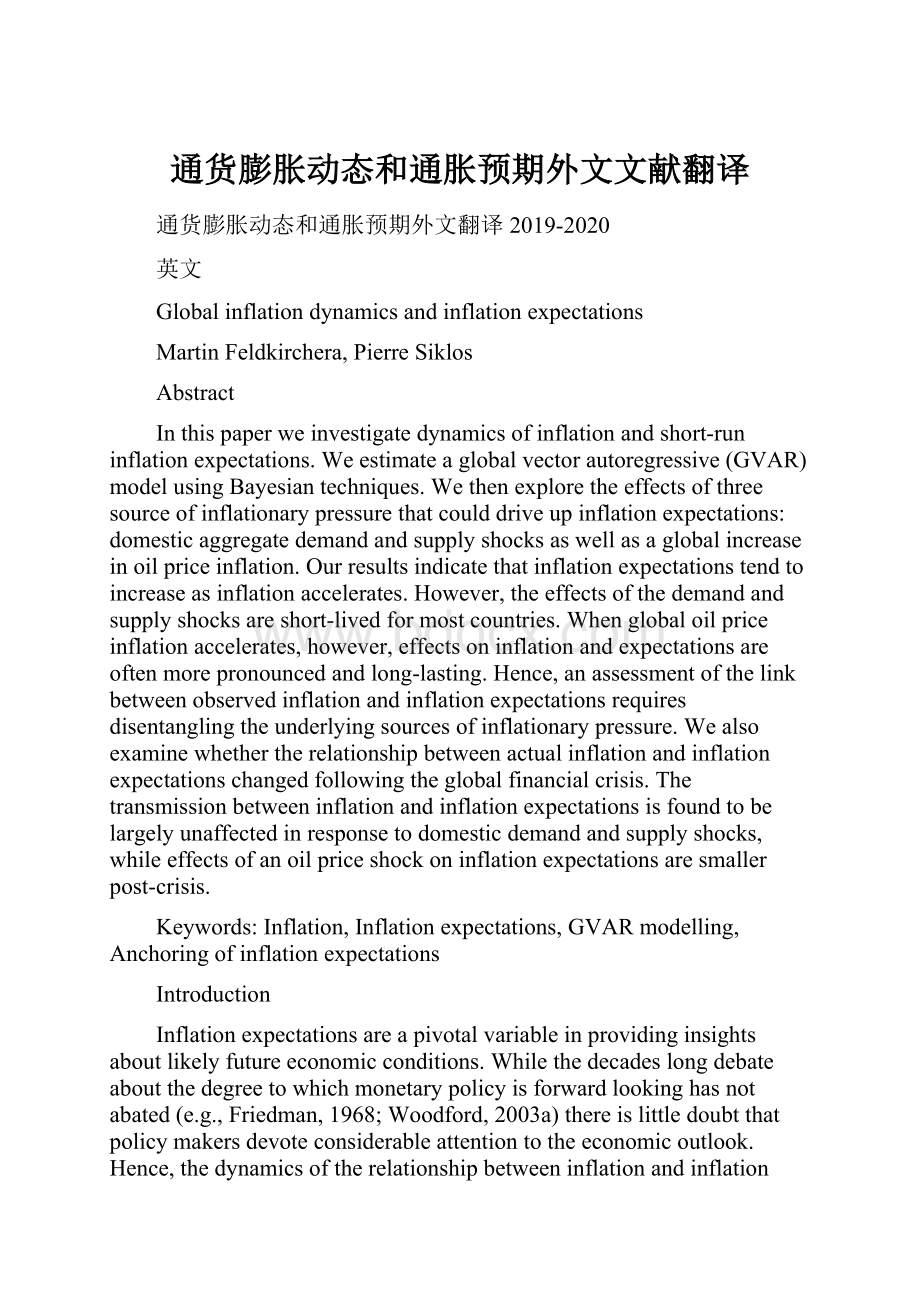通货膨胀动态和通胀预期外文文献翻译.docx
《通货膨胀动态和通胀预期外文文献翻译.docx》由会员分享,可在线阅读,更多相关《通货膨胀动态和通胀预期外文文献翻译.docx(19页珍藏版)》请在冰豆网上搜索。

通货膨胀动态和通胀预期外文文献翻译
通货膨胀动态和通胀预期外文翻译2019-2020
英文
Globalinflationdynamicsandinflationexpectations
MartinFeldkirchera,PierreSiklos
Abstract
Inthispaperweinvestigatedynamicsofinflationandshort-runinflationexpectations.Weestimateaglobalvectorautoregressive(GVAR)modelusingBayesiantechniques.Wethenexploretheeffectsofthreesourceofinflationarypressurethatcoulddriveupinflationexpectations:
domesticaggregatedemandandsupplyshocksaswellasaglobalincreaseinoilpriceinflation.Ourresultsindicatethatinflationexpectationstendtoincreaseasinflationaccelerates.However,theeffectsofthedemandandsupplyshocksareshort-livedformostcountries.Whenglobaloilpriceinflationaccelerates,however,effectsoninflationandexpectationsareoftenmorepronouncedandlong-lasting.Hence,anassessmentofthelinkbetweenobservedinflationandinflationexpectationsrequiresdisentanglingtheunderlyingsourcesofinflationarypressure.Wealsoexaminewhethertherelationshipbetweenactualinflationandinflationexpectationschangedfollowingtheglobalfinancialcrisis.Thetransmissionbetweeninflationandinflationexpectationsisfoundtobelargelyunaffectedinresponsetodomesticdemandandsupplyshocks,whileeffectsofanoilpriceshockoninflationexpectationsaresmallerpost-crisis.
Keywords:
Inflation,Inflationexpectations,GVARmodelling,Anchoringofinflationexpectations
Introduction
Inflationexpectationsareapivotalvariableinprovidinginsightsaboutlikelyfutureeconomicconditions.Whilethedecadeslongdebateaboutthedegreetowhichmonetarypolicyisforwardlookinghasnotabated(e.g., Friedman,1968; Woodford,2003a)thereislittledoubtthatpolicymakersdevoteconsiderableattentiontotheeconomicoutlook.Hence,thedynamicsoftherelationshipbetweeninflationandinflationexpectationscontinuestopre-occupythemonetaryauthoritiesandcentralbankers.Evenbeforethefullimpactoftheglobalfinancialcrisis(GFC)of2008–9wasfeltintheUS,andinmanyotherpartsoftheglobe,centralbankerssuchas Bernanke(2007) highlightedtheimportanceofinflationexpectationssince“…thestateofinflationexpectationsgreatlyinfluencesactualinflation…“.Morerecently, Yellen(2016) alsounderscoresthecrucialroleplayedbyexpectationswhilebemoaningthefactthattheprofessionmustconfrontgapsinourknowledgeabouttherelationshipbetweenobservedinflationandtheshort-runinflationexpectationsthatliesattheheartofmanytheoreticalmacroeconomicmodels.Itisnotdifficulttocomeacrossspeechesbycentralbankerswho,onaregularbasis,touchuponthesubjectoftheformationandimplicationsofinflationexpectations.
Amain,butnotsole,driverofinflationexpectationsispastinflation.Attheriskofsomeover-simplification,inflationcanbethoughtofasbeingdrivenbytwosetsofdeterminants,namelylocalordomesticfactorsversusinternationalorglobalforces.Thelocaldeterminantswouldincludetechnicalprogressandchangesinproductivity,demographicfactors,institutionalconsiderationssuchastheadoptionofinflationtargetingandcentralbankindependenceand,since2008,theadoptionandmaintenanceofunconventionalmonetarypoliciesinsystemicallyimportanteconomies.Moregenerally,however,economiststendtomakethedistinctionbetweenaggregatedemandandsupplysourcesofchangesininflationpressure.Inwhatfollows,weretainthisdistinctiontoallowforgreatercomparabilitywiththeextantliteratureaswellasbecauseitprovidesuswithavehicletopresentnewinsightsintotheunderlyingdriversofinflationandultimatelyaboutthelikelihoodthatinflationexpectationscanbeanchored.
Globalizationinboththetradingofgoodandservicesandinfinanceisoftenalsotoutedasacriticaldriveroftheinternationalcomponentthatinfluencesdomesticinflationrates.Asaresult,theextantliteraturehasdivergedwhereinsomearguethatmodelsofinflationaretoonationcentric(e.g., Borio&Filardo,2007; Ahmad&Civelli,2016; Auer,Borio,&Filardo,2017, Kabukçuoğlu&Martínez-García,2018)whileothersplacegreateremphasisonthevariouslocalfactorsmentionedabove.
Thecurrentliteraturegenerallyfocusesonahomogeneoussetofcountries(e.g.,advancedoremergingmarketeconomies;seethefollowingsection).Wedepartfromthisnormtoconsider42economiesthatspanawiderangeintermsoftheirsize,successatcontrollinginflation,monetarystrategiesinplace,andtheextenttowhichtheyweredirectlyimplicatedornotintheGFC.Tofullyexploitthepotentialforcross-borderspilloversininflationweusetheGlobalVARs(GVAR)methodology(Pesaran&Chudik,2016).Thismethodologyiswellsuitedtoaddressthedomesticimpactofchanginginflationonexpectationsdynamicscontrollingforinternationalspilloversthroughcross-borderinter-linkages.
Often,globalfactorsareconstructedusingsomeindicatoroftradeopennesstoaggregatecountry-specificseries.Nevertheless,thereisdisagreementaboutwhetherthisistheappropriatevehicletoestimateglobalversuslocalinfluencesondomesticinflation(e.g., Kabukçuoğlu&Martínez-García,2018; Ahmad&Civelli,2016).Instead,weproposeanovelsetofweightsinestimatingtheGVARobtainedfromtheforecasterrorvariancedecompositionsestimatedviathemethodologyof DieboldandYilmaz(DY,2009) developedtomeasurethedegreeofconnectedness.SincethedebateaboutlocalversusglobaldeterminantsofinflationexpectationspartlycentersaroundtheextenttowhichcountriesarelinkedtoeachothertheDYtechniqueisanaturalonetouseinthepresentcircumstances.Indeed,theforegoingcombinationofmethodologiespermitsustohighlighttwoneglectedaspectsofthedebateaboutwhatdrivesinflationandinflationexpectations.First,thattherelativeimportanceoflocalversusglobalfactorsislikelyafunctionofthepolicyhorizon.Second,theglobalizationofobservedinflationisalsoreflectedinaglobalizationofexpectedinflation.WhiletheGVARmethodologyprovidesaveryrichsetofpotentialshocksthatmaybeanalyzed,wefocusontwosetsofshocks.Theyare:
theimpactofdomesticaggregatedemandandsupplyshocksoninflationandinflationexpectationsandtheimpactofaglobaloilpricesupplyshockonthesesametwovariables.
Briefly,wefindthatinflationexpectationsrespondpositivelytoeitherdomesticaggregatedemandorsupplyshocks,buttheeffectsaregenerallytemporary.Thisfindingholdsequallytrueforthepost-crisisperiod.Bycontrast,ifinflationacceleratesduetoapick-upinglobaloilpriceinflation,inflationexpectationsrespondsignificantlypositiveandeffectsarelonglasting.Theimpactoninflationisevenlargerthanoninflationexpectations.Hence,oilpriceshocksdriveawedgebetweeninflationandinflationexpectationsevenamongprofessionalforecasters.Nevertheless,actualinflationandinflationexpectationstendtoco-movecloselyandthepass-throughhasdiminishedintheaftermathofthecrisis.Therefore,inanerawhereenergypricesarevolatileandaresubjecttolargeswings,thishasimplicationsforwhenandhowaggressivelymonetaryauthoritiesoughttorespondtooilpriceshocks.Anadditionalimportantimplicationisthatidentifyingtheaggregatesupplyfromaggregatedemandcomponentsofshocksiscriticaltounderstandingthedynamicsofbothobservedandexpectedinflation.
Literaturereview
Inflationexpectationslieatthecoreofallmacroeconomicmodels(e.g., Woodford,2003a).Moreover,totheextentthatpolicyisabletoinfluencetheseexpectations,understandingtheconnectionwithobservedinflationremainsanessentialingredienttoevaluatingtheimpactofmonetarypolicy.
EspeciallyfollowingtheGFC,thedebatesurroundingthemechanismthatbestdescribeshowexpectationsadjustinresponsetoshocks,aswellaswhatarethefundamentaldriversofinflationexpectations,hasbeenrekindled.Thesameistrueofthecompanionliteraturethatexploresthedynamicsanddeterminantsofobservedinflation.Aneraofultra-lowinterestrates,combinedwithlowinflation,hasalsocontributedtorevivingthestudyanddebateaboutlinksbetweeninflationandinflationexpectations.
Rationalexpectationsserveasaconvenientbenchmark,inpartbecausetheoreticalmodelsarereadilysolvableandclosedformsolutionsaretypicallyfeasible.However,whenconfrontedwiththeempiricalevidence,considerabledifferencesofopinionemergeabouthowbesttodescribetheevolutionofexpectations.Forexample,anearlyassessmentbytheBankofJapanofitsQuantitativeandQualitativeEasingprogram(QQE; BankofJapan,2016)findsthattheJapanesearepronetoadjustinginflationexpectationsmoregraduallythaninotheradvancedeconomies(e.g.,theUSortheeuroarea).Thisislargelyduetothebackward-lookingnatureoftheseexpectations.ThisalsoresonatessomewhatwithrecentevidencefromtheUS(e.g., Trehan,2015)andothereconomiesbothlargeandsystemicallyimportantaswellasonesthataresmallandopen(e.g., Bhatnagaret al.,2017).
Ofcourse,theremaybeseveralexplanationsforthesluggishadjustmentofinflationexpectations.Japan,aftertwodecadesormoreofverylowinflationtolowdeflation,setsthiscountryapartfromtheremainingadvancedeconomieswhich,overthesameperiod,experiencedonlypassingboutsofdeflation(early2000sandintheaftermathofthe2007-8globalfinancialcrisis). Sincethattime,below‘normal’inflationrateshavespreadacrossmuchoftheadvancedworld.Unsurprisingly,thishasattractedtheattentionandtheconcernofpolicymakers.Thisrepresentsarelativelynewele